And the Ship Sails On, 1984, directed by Federico Fellini, written by Federico Fellini and Tonino Guerra.
The tenth literary rule Mark Twain accused James Fenimore Cooper of breaking in "James Fenimore Cooper's Literary Offenses" goes like this:
...the author shall make the reader feel a deep interest in the personages of his tale and in their fate; and... he shall make the reader love the good people in the tale and hate the bad ones. But the reader of the "Deerslayer" tale dislikes the good people in it, is indifferent to the others, and wishes they would all get drowned together.
Well, one thing you can say about And the Ship Sails On: Fellini may have broken Rule 10, but at least he gave me what I was wishing for. I tried to like this movie. I saw it several times. I read everything I could find about it. But it seems to be the work of a different director than Nights of Cabiria, and not a better one.
And the Ship Sails On is the story of a doomed ocean liner travelling through the Mediterranean during July of 1914. Austrian archduke Franz Ferdinand was assassinated on June 28 of that year; the first armed clashes of World War I took place in early August. So the action of the movie takes place in the lull as Europe geared up to tear itself to shreds. Until the last third of the movie, however, history barely impinges on the quotidian concerns of the aristocratic passengers. The purpose of their voyage is to scatter the ashes of a recently deceased operatic diva near the island where she was born. Most of the passengers are connected in some way or another to the world of music, with two exceptions. The first is a journalist named Orlando, played by Freddie Jones (who you probably recognize from many of David Lynch's movies):
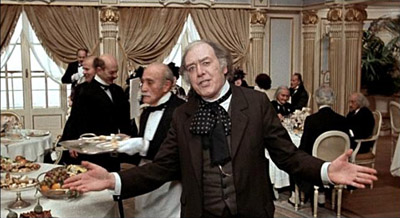
Orlando serves as the audience's guide to the dozens of characters on board the ship; he's there because he's making some sort of documentary about the voyage. Sometimes he is accompanied by a cameraman, sometimes he just addresses Fellini's camera. When Orlando addresses the camera (as he does quite often), you're rarely sure whether Orlando is breaking the fourth wall or just talking to his cameraman. The idea of a talking-head-style journalist in the silent era is one of the better jokes in the movie, but I found Orlando's asides more distracting than effective, not least because of the constant blurring of the real asides with narration that happens within the world of the movie. Fellini actually opens with this kind of blurring: the initial footage is scratchy and silent, complete with intertitles, and people react to the camera like the novelty it is:
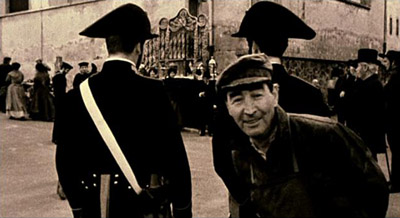
But before Fellini switches from silent footage, we see the cameraman and his camera; we're looking through an invisible camera as in most movies. It's playful but he keeps switching back and forth throughout the film, and you're never certain whether a character is going to react to the camera or not.
The other passenger who doesn't really belong to the world of opera is an Austrian Archduke. He's more fortunate than Franz Ferdinand, in that July of 1914 finds him still among the living, but less fortunate in that he seems about as likely to grow a mustache like Franz's as he is to grow wings. He looks like a castrato, and the few times you hear him speak about foreign policy don't inspire much confidence.
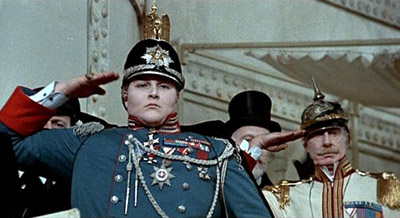
You could read the Archduke's feminine appearance as a critique of the aristocrats who were marching Europe into disaster during the time of the movie, but he doesn't look much worse than anyone else in this film. To put it bluntly, the passengers look like the walking dead throughout the movie. Here, for instance, is Shakespearean actor Barbara Jefford in a relatively recent photo:

So here's what Fellini made her look like in And the Ship Sails On.
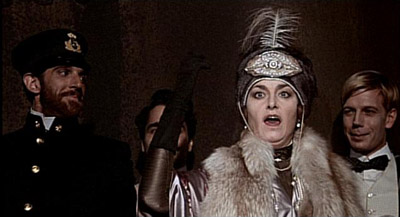
Not a good look for her. And she's held up as the heir to the operatic throne the dead diva has recently vacated. Jefford, by the way, was stunning in the fifties and sixties, but that didn't seem a fair comparison. But in a movie where nobody looks good, nobody looks quite as bad as German dancer Pina Bausch, playing the Archduke's blind sister. Here she is, in the single least attractive kiss since The Shining:
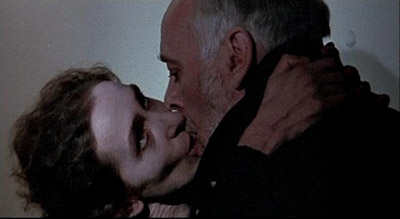
The movie isn't easy to look at; I don't know if the quality of the transfer is responsible, but as you can see, the colors are pretty washed out. As muddy and unappealing as I found the look of the film, however, it was nowhere near as distracting as the sound. Freddie Jones speaks his lines in English, as do several other actors; they've all been dubbed in Italian with near complete indifference to the movement of his lips. Once I realized some of the actors were speaking English, I found the movie difficult to watch, because I couldn't stop lip-reading. Italian films almost never use direct sound, but if you compare five minutes of Nights of Cabiria with five minutes of And the Ship Sails On, you can immediately see the difference between good and bad postsynchronization work. This isn't strictly a function of Fellini letting his English-speaking actors act in their native tongue, either; the Italians do an excellent job of dubbing American movies so that they appear to feature direct sound.
And even if the synchronization were perfect, the sound mix would be hard to listen to. All the voices are mixed at the same level and it sounds as though at most four actors were employed. There's no variation in tone, and some of the voices (the general who accompanies the Austrians, for example) sound like nothing human. Even when the actors are clearly saying their lines in Italian, the same lines as on the audio track, the sound doesn't even come close to corresponding to the image. You can make a case that this is a Brechtian device for distancing the audience from the seductive spectacle of cinema. In fact, the rest of the movie supports this idea: Fellini deliberately uses very artificial special effects and, at the end, has the camera pull back to show the ship's deck in its stage at Cinecittà. But I'm skeptical of film analyses that make subtle virtues out of apparent shortcomings, and whether these are deliberate technique or just indifference, it made the experience of watching the movie excruciating. To me, cinema's seductive qualities are kind of the point.
But perhaps this is an unfair criticism, akin to looking for plot holes in Armageddon. As Vincent Canby (who loved the movie) pointed out, And the Ship Sails On "doesn't depend for 10 seconds on anything as conventional as identifiable characters or a narrative." And as we've seen, it also doesn't depend on technical virtuosity. What's left is something you have to watch sort of like you would a sketch comedy show; there are individual scenes and images that work, but looking for anything else will only lead to disappointment. The movie gets better toward the end, when the aristocrats' voyage is disrupted by the world outside, first in the form of Serbian refugees. The refugees look more alive than anyone on screen to that point, and they have the obligitary scene where they play music and dance with greater charm and skill than the upper classes:
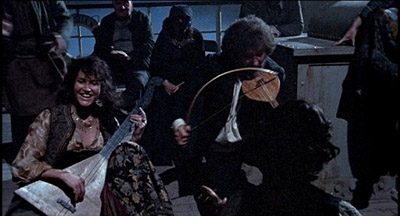
That scene's a cliché, but I liked it anyway. And even the shoddy model work occasionally pays off; I liked the looks of the Austrian warship that appears to capture the Serbian refugees. It looks like an Orion-class battleship as designed by Terry Gilliam:
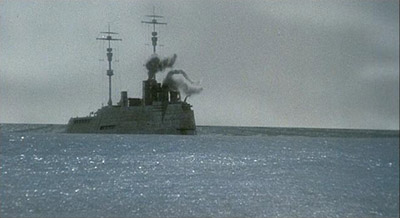
Note the obvious cellophane sea in that shot; actual water is a rarity in this film. And Fellini does continue to have the same talent for surrealism that characterizes his great films from the sixties. The most notable sequence of this type in And the Ship Sails On is a semi-successful attempt at bathing a rhinoceros, the ship's most unhappy passenger.
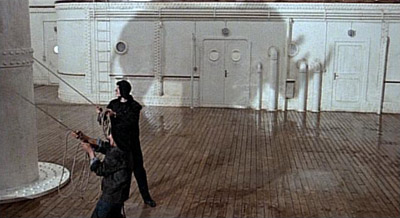
The movie's at its absolute best when Fellini is playing with the paradoxes of a media-driven life. The diva whose ashes are at the center of the story keeps getting resurrected, first by an impersonator, then by Victrola, and finally by film, coming most fully to life as the ship sinks:

But Fellini doesn't linger on this (or any of his most effective images) long enough to provoke more than a momentary pleasure in the viewer. Nights of Cabiria was a focused character study with humanity shining through in every shot; 8½ is made with a clear affection for its main character. And the Ship Sails On feels like the work of someone who has fundamentally lost interest in other people; no one but the dead diva seems human. Now I'm not opposed to detached, academic filmmaking per se, but I think for a movie in which we don't care about the characters to work, it has to be well structured and technically competent. And the Ship Sails On, I am sorry to report, struck me as neither.
Randoms:
- In all fairness, I should note that I am unqualified to judge the operatic music that's a big part of the film. As Canby points out, Fellini uses chopped bits of opera scores, with different lyrics, throughout the movie. Unfortunately, the music is not well mixed, and the new lyrics are not subtitled. The DVD features no commentary tracks, and there doesn't seem to be much criticism of the film available online. So without a better knowledge of Italian (or better hearing) than I've got, you're pretty much on your own as far as teasing out what Fellini is up to with this. I'm prepared to believe that I missed the key that would have made the movie seem brilliant to me. But I could have used more help from the DVD.
- The strangest thing about the shot where the camera pulls back to reveal the set at Cinecittà is this guy:
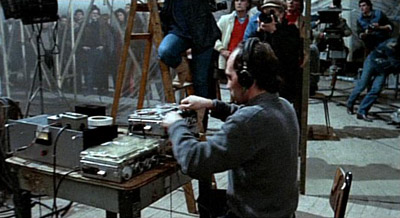
- Clearly recording sound during the shoot (there's a boom mike visible, as well). What did they do with these tapes? They don't seem to have been used—even as a reference—when the postsynchronization work was done.
- Like I said above, Fellini does a good job of playing around with mediated experience in this movie. Here's the thing, though: And the Ship Sails On premiered at the Venice Film Festival in September of 1983. That means it arrived seven months too late, because the February before, David Cronenberg's Videodrome was released. The two films have some of the same concerns (both even feature characters who only exist in mediated form: the diva in And the Ship Sails On and Professor O'Blivion in Videodrome). But to me Videodrome seems fresh and alive, while Fellini's film seems as antiquated as its sets.


11 comments:
I hope we get your comments on Videodrome before the year 2010.
By 2010 I'm planning on existing only through prerecorded blog posts, anyway.
Andrew Rudin said...
The highly skillfull interweaving of the many quotes from classical music is intriguing but even those familiar with the items used will not find it significantly raises the level of interest in this movie. Italian items used center mostly on bits of La Forza Del Destino (The force of destiny), a scrap of the chorus of hebrew slaves, "Va, Pensiero", and part of an aria from Aida. This is countered (appropriately enough) with some Austrian (Strauss) waltzes. Rather more puzzling is the use of Debussy's Clair de Lune, and "Footsteps in the Snow".
Andrew,
There are a lot of puzzling things about the movie. Thanks for the info -- glad to know I wasn't missing some secret key that turned it into something brilliant.
Thanks for sharing your response to this late Fellini film. You give some good information that is not available elsewhere, as far as I know.
I would like to say, however, that I, at least, enjoyed the film a lot more than you did. I thought the first ten minutes (the silent sepia opening scene) was brilliant and funny. And, maybe because I'm newly interested in opera (in part because of the Met's HD transmissions) I enjoyed the play of music throughout the movie.
Some of the details you mention have other interpretations. That bizarre kiss between the princess and the minister of state was purposefully strange, I think, for as we learn later in the film, she has lured him into revealing his treasonous plans. The handsome actress who plays the rival to the dead opera star looks the way she does because she is eaten up with longtime envy and newly formed fear that she will not be able to equal her rival.
For me unforgettable moments include the scene where the toffs visit the furnace room of the ship and sing in the huge echoing chamber to the Bravos! of the stevedores. I remembered that scene from when I saw the movie in the 80s. And the scene when the ashes of the diva blow toward her island as her recorded voice fills swells is unforgettable, too.
I come to this movie as a huge fan of many of Fellini's films and find And the Ship Sails On to be among his best--a light and skillful meditation on art, artifice, music, class, war, and memory.
I think I remember reading that at this time in Fellini's career, he decided to dub the voices afterward and only use background noises and such.
The reason behind it was because he was moving away from a more realistic approach as he had done in Cabiria and moving more into a dreamlike reality.
Yes, it is annoying, but it had actually been planned on his part and not a 'mistake' on Fellini or Criterions part. That is if I remember this correctly. Which, after hearing this, finally I got passed the fact and watched it the whole way through.
I love this film also, more because it shows me a certain love for music of many types of artists that have the same art form. Much like everybody at the end when it reveals the many people working on the film, doing their different duties.
Love your blog, you have many good insights.
Javier Alan Garcia
Having just watched the film again last night, I must say you seem to have entirely missed the main charm of the film, which is that it is absurdist. You may prefer conventional narrative, but that is very obviously not what Fellini was going for here. I mean, the film keeps turning into a spontaneous opera! I find it by far the funniest of all Fellini's films; in fact, one of the funniest films ever made by anybody.
I know that you reviewed this movie a long time ago now but I liked the film more than you. It's one of Fellini's minor masterpieces. The antiquated sets are part of the revealing of the other side of the curtain which I think Fellini was intent on revealing. Of course the sea is not real, these are opera singers . . .But reality is revealed, not the less, we are ushered into a new era.
Love the pictures and the information. Thanks.
Here’s an interesting quote by Fellini: "All my films turn upon this idea— there is an effort to show a world without love, characters full of selfishness, people exploiting one another, and, in the midst of it all, there is always—and especially in the films with Giulietta—a little creature who wants to give love and who lives for love."
As noted, this premise is especially effective when the “little creature” is Giulietta Massena. When that “little creature” is a rhinoceros, not so much. That, for me, is the biggest problem with And the Ship Sails On. Because there isn’t a single loveable character for me to align myself with, the film alienates me emotionally. Fellini also distances us with his persistent reminders that we are watching a film (and sometimes a film within a film). I admire that as an intellectual construct, and it’s probably part of the point--the world is dominated by artifice, puerility and cruelty. In fact, I admire several things here (the opening sequence, the boiler room sequence, the music, the humor), but I wasn’t captivated by any of it. In a film where everyone is despicable, it’s a struggle not to despise the film.
Great review!
We're linking to your article for Fellini Friday at SeminalCinemaOutfit.com
Keep up the good work!
Those of you who dislike this film, are unable to distinguish art from artifice. This is the master at the height of his powers; he beckons the moon, he summons the seas, he breaks every convention of storytelling and satirizes movie making. Everyone seems to have missed the rhinoceros as analogy to the ship's rat for scale. This is easily one of Fellini's best. You are nitpicking a masterpiece; let go....
Post a Comment